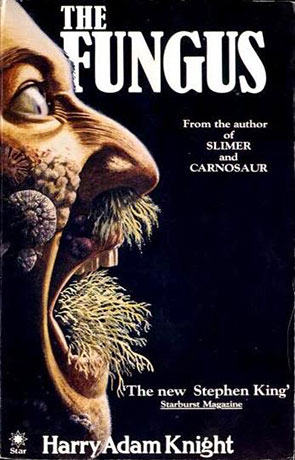 By HARRY ADAM KNIGHT (Star Books; 1985)
By HARRY ADAM KNIGHT (Star Books; 1985)
London is destroyed yet again in this 1980s example of “Nasties” horror writing. The author was the late John Brosnan (1947-2005), writing in collaboration with Leroy Kettle under the Harry Adam Knight pseudonym (under which Brosnan and Kettle also published SLIMER and BEDLAM). The reception of THE FUNGUS (published in the US as DEATH SPORE) was split between the views of author/editor David Langford, who dismissed it as “revolting,” and Clive Barker, who dubbed it a “damn good time.” I’m in agreement with both views.
The book begins in tried-and-true Nasties fashion, with chapters focused on characters who are provided with mini-biographies and then killed off. The agent of those deaths is a super-fungus that infects peoples’ bodies via floating spores, in which manner it causes the deaths of a group that includes a lesbian couple (a shocking element for 1985, albeit one that wasn’t too unusual for the subgenre), a “grossly overweight man” and a slimy landlord. Then also exist people whose bodies develop a symbiotic relationship with the fungus, which also infects wood, metal, electric wires and even airplane fuel.
It seems that Dr. Jane Wilson, a mycologist employed by a biological institute, has been attempting to solve the world’s hunger crisis by breeding a mushroom species that has grown out of control. It’s up to Jane’s estranged husband Barry, a mycologist turned hack novelist, to make his way through a rapidly deteriorating London to his wife’s laboratory so he can retrieve her notes. This entails getting hopped up on some experimental vaccines and joining Dr. Kimberly Fairchild, a travelling companion/love interest, for a trip into Hell on Earth—and there’s a time limit, as the UK government, under pressure from the rest of the world, is planning on nuking London. Can Barry complete his mission, and keep from getting infected, before the planned detonation?
The book is suitably pulpy in a manner that bridges the gross out aesthetic of the nasties school with the more refined formula of disaster-minded British scribes like John Wyndham and Sam Youd. It’s well plotted, if a bit too laid back for my tastes; despite the apocalyptic arc there’s little sense of urgency, with the overly scant 220 page length ensuring that the book never fully exploits its concept, nor that concept’s real world implications (which in the post-covid era have taken on an entirely new prominence).
The authors’ primary interests were evidently the infection passages. Featured is a great deal of compellingly gross imagery, such as the finding of an exploded body (“Eric Gifford’s head, one of his arms, and both of his legs still lay on the bed but the rest of him was spread fairly thickly over the ceiling, walls and floors”), the sight of a massive stinkhorn that “looked like the erect penis of a sleeping giant” and a description of a fungus infected rapist’s penis breaking off (yes, sexually-tinged descriptions tend to predominate). So for receptive readers (i.e. sick fucks) THE FUNGUS makes for textual fast food, an enjoyable but not entirely filling read.

